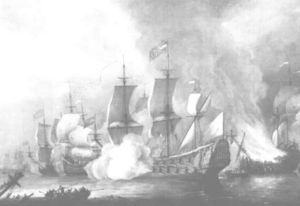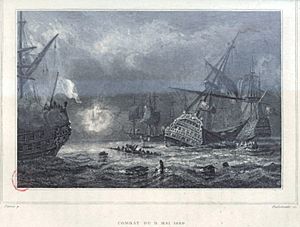Battle of Bantry Bay facts for kids
Quick facts for kids Battle of Bantry Bay |
|||||||
|---|---|---|---|---|---|---|---|
| Part of the Nine Years' War and Williamite War |
|||||||
 Battle of Bantry Bay by Adriaen van Diest. |
|||||||
|
|||||||
| Belligerents | |||||||
| Commanders and leaders | |||||||
| Earl of Torrington | Châteaurenault | ||||||
| Strength | |||||||
| 19-22 ships | 24 ships | ||||||
| Casualties and losses | |||||||
| 94 killed c. 300 wounded No ships lost |
40 killed 93 wounded No ships lost |
||||||
The Battle of Bantry Bay was a sea fight that happened on 11 May 1689. It took place just before a bigger war called the Nine Years' War officially started. In this battle, the English navy fought against the French navy.
The English fleet was led by Admiral Arthur Herbert. He later became the Earl of Torrington because of his actions. The French fleet was commanded by François Louis de Rousselet, Marquis de Châteaurenault. This was the first time the main English and French navies had fought a big battle since 1545.
The battle happened near the coast of southern Ireland. It didn't have a clear winner, but the French managed to deliver important supplies. These supplies were for King James II, who was trying to get his throne back. Even though the French won the battle, they didn't use this win to gain a bigger advantage. However, Châteaurenault's fleet did a lot of damage to the English ships.
Why the Battle Happened
After the 'Glorious Revolution' in 1688, King James II of England lost his throne. He was replaced by William, Prince of Orange, who ruled with his wife Mary. James went to France, where King Louis XIV helped him. Louis XIV believed James had a God-given right to be king of England. He also wanted to support James because a war in Ireland would keep William's forces busy. This would stop William from focusing on other areas, like the Spanish Netherlands.
While in France, James built an army to help his supporter in Ireland, the Earl of Tyrconnell. James had already sent money. In March 1689, he was ready to sail to Ireland himself to lead the fight. He landed in Kinsale with 100 French officers and about 2,500 soldiers. James and Tyrconnell then went to Dublin.
James hoped to quickly control Ireland. But this was hard because Protestant strongholds in northern Ireland were still against him. His army urgently needed supplies and equipment from France. However, English leaders were worried about the situation in Ireland. They decided to use the Royal Navy to stop James from getting what he needed.
The Battle Begins
The new leader of the English fleet, Arthur Herbert, didn't sail until early April. Some of his ships had problems because their crews hadn't been paid. Herbert's fleet of 19 ships left on April 4. By April 12, they were near Cork, looking for enemy ships.
The French fleet left the port of Brest on May 6. It had 24 main warships, two smaller ships called frigates, and many fireships. It also carried ships with weapons and supplies for James's army.
As the French ships got close to southern Ireland, Herbert's fleet made it impossible to unload supplies at Kinsale. So, the French commander Châteaurenault had to anchor his fleet in Bantry Bay. Three more French frigates joined them there.
The next morning, May 11, the French were landing 1,500 men with money, weapons, and ammunition. That's when Admiral Herbert's fleet appeared. The French ships quickly prepared to move. A battle started in the narrow waters of the bay.
At first, the two fleets lined up against each other. But Châteaurenault had the advantage of the wind. He pushed Herbert's ships out of the bay and into the open sea. The battle lasted four hours. It didn't have a clear winner, but the French ships successfully protected their transport ships. These ships managed to unload all their supplies. When the French stopped fighting late in the afternoon, Herbert's ships were too damaged to follow them. He had also lost many men.
After the Battle
After the battle, both fleets left. Châteaurenault returned to Brest on May 18. On his way, he captured seven Dutch merchant ships. Herbert sailed to the Scilly Isles, then to Spithead, stopping at Plymouth. He arrived on May 22.
Both the French and English were not fully happy with the battle's outcome. Herbert's ships were so damaged that they had to stay in Portsmouth for two months. This left the waters around Ireland unprotected. Châteaurenault didn't use his advantage to attack more, which disappointed some of his officers.
King William was also not pleased with the result. However, he made Herbert the Earl of Torrington. This was mainly to thank him for his work during the 'Glorious Revolution' the year before. The King also made two of Herbert's captains, John Ashby and Clowdisley Shovell, knights. He also gave the sailors a bonus of ten shillings each.
Meanwhile, James had started the Siege of Derry. Taking Derry would help him connect with his supporters in Scotland. Three French frigates were sent to help him. In response, the Scottish parliament sent two small ships, the Pelican and the Janet. But on July 20, the French captured both of them.
The English and their allies, the Dutch, started to build up their navy in the Channel. Their fleet soon had 34 English and 20 Dutch warships. They also had four frigates and 17 fireships. After getting supplies, these ships patrolled south of Kinsale. Their goal was to stop more French supplies from reaching Ireland.
However, the main French fleet from Brest, now joined by more ships, sailed on August 15. It stayed in the Bay of Biscay and didn't threaten England or its supply lines to Ireland. Because of this, the French couldn't stop Admiral Rooke from helping the city of Derry on August 10. They also couldn't stop Marshal Schomberg's army from England landing near Carrickfergus on August 23. With Schomberg's help, William's army in Ireland now had about 40,000 soldiers.
Images for kids






